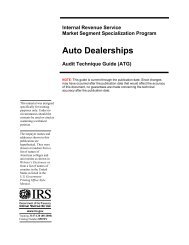Publication 963 (Rev. October 1997) - Uncle Fed's Tax*Board
Publication 963 (Rev. October 1997) - Uncle Fed's Tax*Board
Publication 963 (Rev. October 1997) - Uncle Fed's Tax*Board
Create successful ePaper yourself
Turn your PDF publications into a flip-book with our unique Google optimized e-Paper software.
Social Security Coverage<br />
Chronology<br />
1935 Social Security Act passed providing for Federal<br />
old-age insurance, Federal State public<br />
assistance and unemployment compensation,<br />
and extension of public health services, maternal<br />
and child health services, services for crippled<br />
children, child welfare services, and<br />
vocational rehabilitation services; three member<br />
Social Security Board created to administer<br />
the Act.<br />
1939 Federal Security Agency created with Social<br />
Security Board within it.<br />
1946 Social Security Board abolished and functions<br />
transferred to the Federal Security Administrator<br />
who created the SSA with a Commissioner<br />
of Social Security to run it.<br />
1949 Bureau of Employment Security which administered<br />
unemployment insurance transferred<br />
from SSA to Labor Department.<br />
1950 Social Security Amendments of 1950 allowed<br />
States to cover, on a voluntary basis, employees<br />
not under a retirement system by means of<br />
a Section 218 Agreement beginning in 1951.<br />
1953 Federal Security Agency abolished; SSA<br />
transferred to Department of Health, Education,<br />
and Welfare. Commissioner of Social<br />
Security to be appointed by the President with<br />
the advice and consent of the Senate.<br />
1954 Social Security Amendments of 1954 extended<br />
coverage even further by allowing<br />
states, on an elective basis, to cover State and<br />
local government employees under existing<br />
retirement systems. Many groups of employees<br />
under existing retirement systems had been<br />
adamant against even elective coverage in<br />
1950. However, other groups desired coverage,<br />
so the provision in the 1954 Amendment<br />
resulted. In fact, in a few instances after the<br />
1950 Amendment was passed, an existing retirement<br />
system would be repealed so that coverage<br />
could be obtained, followed shortly<br />
thereafter with the previous system (or a modification)<br />
being reinstituted.<br />
1956 Social Security Amendments of 1956 gave<br />
more opportunities for coverage for State and<br />
local government employees under existing<br />
retirement systems.<br />
1958 &<br />
1960<br />
The 1958 and 1960 Social Security Amendments<br />
added only slightly to the coverage of<br />
the program by bringing in a small number of<br />
individuals in certain categories, principally in<br />
State and local government employment. The<br />
1960 Amendments added a small amount of<br />
coverage, including employment in American<br />
Samoa and Guam.<br />
1965 Medicare was legislated.<br />
1983 States were no longer permitted to terminate<br />
Section 218 Agreements (and those that had<br />
withdrawn in the past were allowed to opt in<br />
again).<br />
1985 Consolidated Omnibus Budget Reconciliation<br />
Act (COBRA) of 1985 mandated, with certain<br />
exceptions, Medicare HI-only coverage for<br />
State and local government employees hired or<br />
rehired after March 31, 1986.<br />
1986 In 1986, Congress enacted the Omnibus<br />
Budget Reconciliation Act (OBRA ‘86). It had<br />
two major effects on the way State entities treat<br />
Social Security taxes under the Federal Insurance<br />
Contribution Act (FICA). First, OBRA<br />
‘86 enacted Section 3121(b)(7)(E) of the IRC<br />
which provides that services covered under a<br />
Section 218 Agreement will be treated as employment<br />
for purposes of FICA, effective with<br />
respect to wages paid after December 31, 1986.<br />
Second, OBRA ‘86 amended Section 218 of<br />
the Social Security Act so that beginning January<br />
1, 1987, State governments were relieved<br />
from the collection of Social Security contributions<br />
from local government entities, and the<br />
liability for verifying and depositing the<br />
amounts owed by local governments. Instead,<br />
each State and political subdivision became<br />
responsible for FICA tax collection and payment<br />
to the IRS, in the same manner as private<br />
employers.<br />
4-6 Federal-State Reference Guide (<strong>1997</strong> Edition)
















